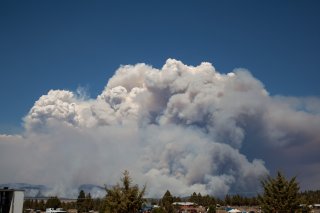During the 2020 fire season, more than 106 large wildfires occurred in the states of Oregon and California. The fires were battled by tens of thousands of wildland firefighters, but still burned more than 6.7 million acres. While thousands of people lost their homes, almost every resident of the state was able to see the impacts of the wildfires on the air: their smoke. So how exactly do wildfires affect air quality?
What Is Considered “Good” Air Quality?
The Air Quality Index (AQI) gives us a daily number to tell us how good or bad the air is. The AQI will also let us know what associated health impacts that quality of air might have. These scores range from 0-500 and the higher the number, the worse the air quality is. When the AQI is ranked from 0 to 50, the air is considered “good quality”. Practically, this means that the level of pollution in the air does not pose a risk to human health.
From 51-100, the air quality is considered moderate. According to the EPA, this means that “Air quality is acceptable; however, for some pollutants there may be a moderate health concern for a very small number of people. For example, people who are unusually sensitive to ozone may experience respiratory symptoms.”
Anything over AQI 100, people start to be at risk. At this AQI, we recommend you keep your windows and doors closed. People at risk should consider wearing some kind of face mask, like a surgical mask, cloth mask, or N95 respirator.
At the time of writing this article, Southern Oregon is experiencing a mild smoke day by the standards of many. But the area still has an AQI of 184.
What Does Wildfire Smoke Put Into The Air?
What a wildfire puts into the air depends on if it is a smoldering or flaming fire. Some fires burn through the underbrush and ground of the forest, smoldering through the vegetation. Flaming fires might jump around the trees and cause massive amounts of flames.
Either of these cause combustion. The chemical release is determined by the temperature and intensity of the combustion.
What is burning is also an important factor. When we are discussing the United States’ fires, usually temperate forests are burning.
We typically see fires send black carbon, nitrogen oxides, and hydrocarbons into the air, as well as the physical contamination contained in smoke.
In short: none of these are good when breathed in by humans.
How Far Can Smoke Spread & Affect Air Quality?
Is anyone safe from wildfire smoke? You might think if you live in an area not commonly impacted by wildfires, you’ll be safe, but that’s not necessarily true. While Oregonians, Californians, Washingtonians, and citizens of other states that commonly deal with wildfires handle the smoke most of the summer, other states are also impacted.
Throughout July, August, and September of 2021, the Bootleg Fire has been burning in Klamath Falls, OR. At the time of writing, the Bootleg Fire was over 400,000 acres in size. While the west coast is feeling the smoke, so is the east coast.
People in New York and all over the eastern seaboard are also experiencing the smoke.
When land burns in that quantity, wildfires have an impact on air quality all over the country. Because the smoke contains physical particles, they don’t just evaporate into the air. They have to go somewhere.
How Can Poor Air Quality Impact Your Health?
Wherever wildfire smoke settles, it does have an impact on health.
We don’t have long-term data, yet, on how the smoke will impact people’s health. But in the last 10 years, it’s been shown to have immune impacts on people who are asthmatic and not.
Smoke is most likely to have short-term impacts on people who have lung conditions, like asthma. The smoke can also increase the risk of respiratory infections, heart disease, stroke, and lung cancer. At risk populations include the children, elderly, and people in low-income neighborhoods.
The biggest threat, though, comes from fine particles. These are the particles that get into your lungs. According to the EPA, “They can cause a range of health problems, from burning eyes and a runny nose to aggravated chronic heart and lung diseases. Exposure to particle pollution is even linked to premature death.”
It’s clear that when the smoke is out, humans shouldn’t be. It has a negative impact on physical health and the difficulties it can cause can also impact on mental health. But if you spend time indoors, there are ways to protect yourself from the wildfire smoke.
How Can You Protect Yourself From Smoke?
Wherever you are in the country, if the wind turns in your direction, you could start to experience smoke in the air. When the outside air quality dips, we start to worry about our indoor air quality. This is where it is important that you understand how to keep your indoor air quality high.
Some things you can do including…
- Wearing a surgical mask or N95 when outside.
- Limiting time spent outside, especially when exercising.
- Keeping doors and windows closed when smokey outside or when the AQI is over 100.
- Monitoring local air quality so you know you’re not inadvertently letting smoke in.
- Getting an air filtration system for your home designed to filter out the smallest of particles.
To know more, please check Lighthouse.

